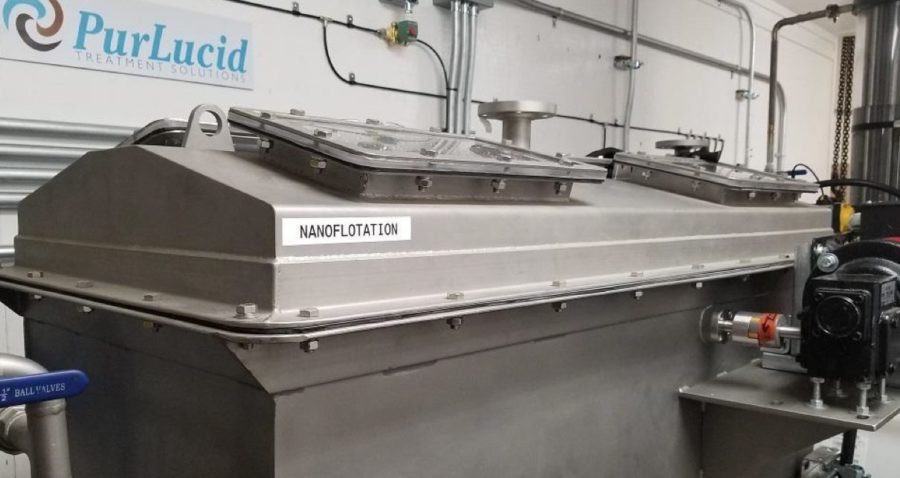MGX sees huge lithium opportunity in Alberta oil sands

The PurLucid Treatment Solutions laboratory in Calgary, Alberta, MGX's partner. Source: MGX Minerals Inc.
By Peter Kennedy

Oil companies could soon be powering the electric car industry. It’s a scenario that looks possible now that Calgary company MGX Minerals Inc. [XMG-CSE; MGXMF-OTCQB; 1MG-FSE] has found a way to extract lithium from waste water produced by Alberta oil sands operations.
This week, MGX said its NFLI-5 commercial scale rapid lithium extraction system is ready for deployment following a successful demonstration in the Calgary laboratories of MGX’s partner PurLucid Treatment Solutions Inc.
MGX shares were unchanged at $1.16 following the announcement on Thursday, June 14, 2018. The stock is trading in a 52-week range of $1.96 and 75 cents.
“On any given day, oil sands producers in Alberta are probably producing more lithium feedstock at a very basic level than all of the lithium companies put together times ten,” said MGX Minerals Chief Executive Officer Jared Lazerson,
Until now, the problem has been extracting that lithium so that it can be used in the production of lithium-ion batteries that are needed to power some essentials of modern life, including electric vehicles, laptops, smart phones and just about every type of portable device.
Currently, most of it winds up in oil sands waste water.
But MGX and Calgary water treatment company PurLucid Treatment Solutions have joined forces to find a way to extract the lithium and at the same time turn the effluent into usable water.
“You need a way of moving vast quantities of water through the system and then grabbing the lithium, and nothing else,” explained Purlucid Chief Executive Officer Preston McEachern.
“In our case, we clean up the water so that they [MGX] can use it,” he said. “Some of the things that are in that water compete with lithium recoveries.”
PurLucid’s technology separates heavy metals and hydrocarbons from brine, purifies wastewater and creates a steady flow of brine feedstock for MGX’s rapid recovery process.
MGX and PurLucid have integrated their respective technologies and fabricated pilot plants that operate as standalones or can be integrated directly into oilfield operators’ existing infrastructure.
Combined, MGX says this Cleantech process does not require the construction of large, multi-phase, lake sized, lined evaporation ponds, greatly reducing the physical footprint and enhancing the quality of extraction and recovery across a complex range of brines that were previously considered un-processable due to complexity or geographical location outside of solar evaporation appropriate zones.
This includes oil and gas wastewater, natural brine, and other brine sources such as lithium-rich mine and industrial plant wastewater.
The final product is lithium fluoride, which can be refined for use in batteries.
Brines (salt ponds) and spodumene (hard rock) represent the two main sources of commercial lithium production.
MGX says extracting lithium from oil sands waste water is a more efficient alternative to hard rock mining of lithium ore, which can be very costly and involves a permitting process that can take years to complete.
The company points out on its website that solar evaporation techniques require a processing period of up to 24 months, and can leave a massive environmental footprint.
The partners believe that as this extraction process moves forward it will move big oil into big batteries.
“Who better to design the renewables [for our] energy future than the guys who have been managing energy for the last 100 years,” said Lazerson.
MGX notes that nearly 20 million barrels of oil and gas are produced daily throughout North America. It goes on to say that for every unit of oil and gas produced, 4-5 units of brine are pumped. As a result, the North American oil and gas industry generates up to 100 million barrels of brine per day, MGX said.
Now that the technology has been proven in the lab and in the test field, the first commercial portable unit will be deployed at a site in northern Alberta later this year.
Meanwhile, on June 5, 2018, MGX said it intends to complete a non-brokered private placement aimed at raising $7 million on a non flow-through basis, as well as a concurrent non-brokered flow through private placement that aims to raise a further $5 million. Total proceeds are expected to be $12 million.
It said the non flow-through financing will consist of an offering of 6.37 million units priced at $1.10 per unit. The flow-through financing consists of an offering of 4.35 million units priced at $1.15 each. Proceeds will be used for qualified mineral expenses at the company’s Canadian projects and for the advancements of the MGX’s lithium and magnesium assets, including continued investment into extraction equipment and PurLucid.
MGX currently holds a 51% stake in PurLucid, but has the right to increase its stake to 100%.
